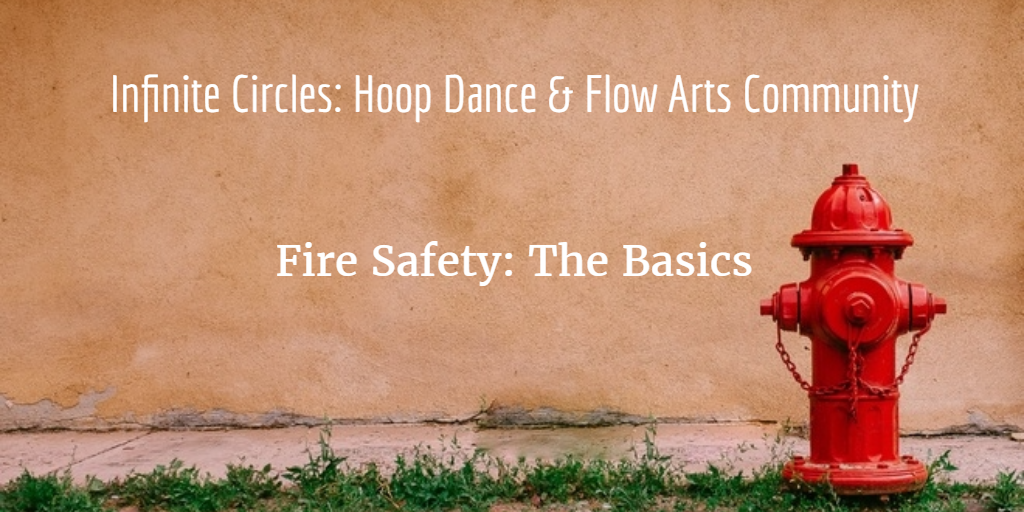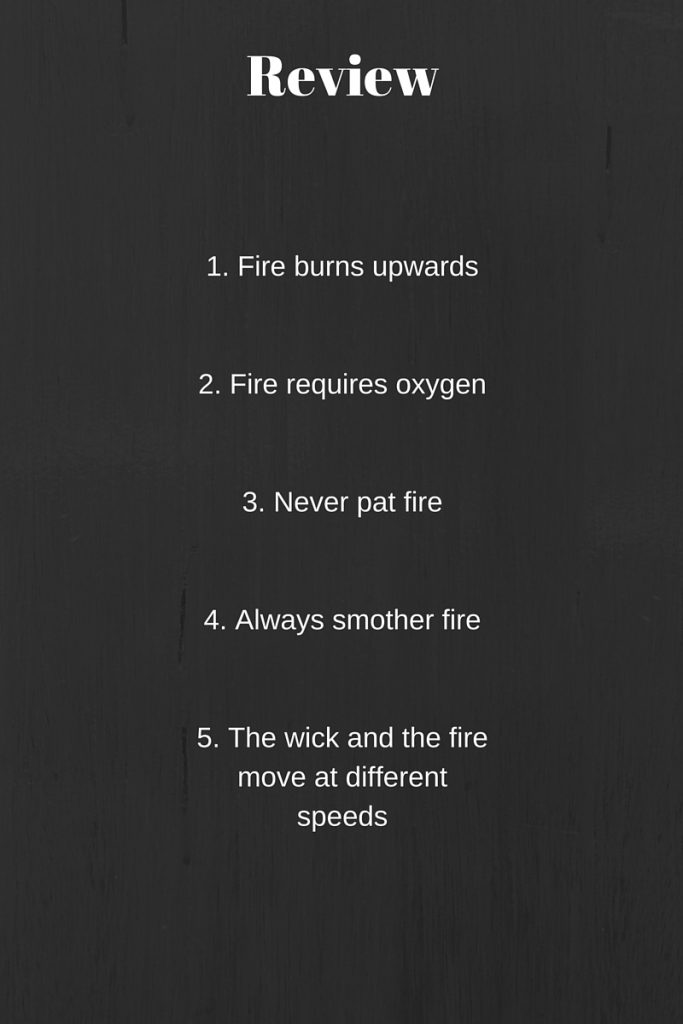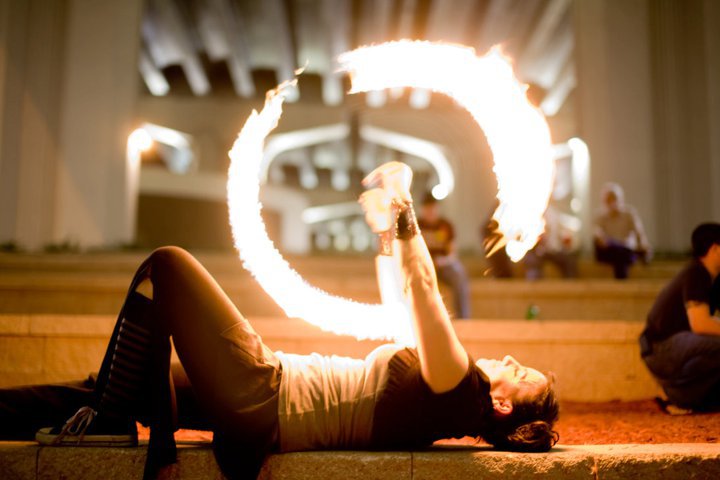Fire Safety: The Basics

In this course on fire safety, we will learn how to use fuel safely, what to wear & what not to wear, the qualities of various fuels, and some first aid tips to know in the event we, or someone around us, gets a burn.
We encourage you to always burn safely. You are protecting not only yourself and the people around you but every fire performer everywhere. One accident can affect the whole community's ability to create art with fire. Be responsible. Be present. Be safe.
Safety knowledge for all fire performers, whether they are first time burners or performers with years of experience:
I. Use Fuel Safely
Contrary to what you may have read in Ripley’s Believe It Or Not, we humans are not very combustible. We are mostly water. With the exception of our hair, there is not much on us that is predisposed to going up in flames. What is flammable is fuel. Once you know this, you know the main action you must take to protect yourself while fire dancing — Use fuel safely!
II. Qualities of Fire
- Fire always burns from the bottom up. The flame from a burning hoop held in the vertical plane can come up and burn through the hoop. Hold hoops horizontally if they are not moving.
The flame from burning poi rises up toward the hands. Keep the poi gently swaying to keep the fire away from the hands.
The flame from fans held straight down will come up toward the knuckles. Instead, hold the lit part of the fan down and a bit out to create the illusion of holding it straight down. - Fire requires oxygen to burn. If you spin faster, you give a flame more oxygen so your burn time will be less. If you spin slower, you give a flame less oxygen so your burn lasts longer. If you have a flame on your clothing and you pat at it frantically, it will feed oxygen to the flame and make matters worse. Instead, cup your hand over the fire, push downward, and smother the fire. If you have a fire in your metal fuel bucket, put the lid back on the fuel bucket, deprive the fire of oxygen, and the fire will go out. Fire can suck the oxygen out of a room quickly. People in house fires sometimes die of asphyxiation before smoke inhalation. If a fire is on the other side of a door, do not open that door and feed the fire oxygen. Fire blankets smother fires by depriving them of oxygen.
- Fire is loud and it’s even louder when you give it oxygen (i.e, when your tool is spinning.)
- Fire is bright and looking into it can leave you temporarily blinded. Instead, look out over the flame.
- Fire is lugubrious. We move faster than fire burning at the end of a wick, therefore, if you are using a fire sword (or fan or staff), do not hold your tool flat and then push forward (like you’re fencing) because even though the tool moves forward, the fire stays where it is for a moment before it catches up to the tool. It is better to move backward with fire, away from it, than forward with fire, into it.

III. What to Expect When Spinning Fire
- Fire can be disorienting. It’s very hot and the roar of the fire is very loud. Be calm and breathe. It may feel closer to you than it is.
- Remember fire burns from the bottom up so don’t burn yourself or your tool by holding it over the flame.
- Do not stare directly at the flame. Instead, fix your gaze on an object outside the fire. If you do look into the fire and become blinded, avoid turning, soften your knees, look out over the fire and allow your eyes to readjust.
- Do not be intimidated by the train-like sound of the fire.
IV. Before You Use Fire
- Never light up alone.
- Never perform or practice with lit tools while under the influence of any substance. This includes prescription medications which impair concentration, coordination or judgment.
- Do not engage in fire dance if you are in any condition other than fully awake, aware, and capable. More than one fire dancer who burned themselves did so because they were tired or distracted by something in their life.
- Know that spinning fire is risky. Learn what you can do to minimize the risk but know that you are taking one. Exercise caution, make good choices, and practice good risk management.
- Practice extensively with an unlit fire tool to become familiar with the tool before lighting up. This is especially true for hoopers! Too many never practice with their unlit hoop again after that first burn.
- Practice all new moves with an unlit tool until you are proficient with that move.
- Practice controlled breathing so you are exhaling, not inhaling if the fire is close to the face. This protects you from breathing in smoke and fuel-related chemicals as well as fire.

V. Prior to Fire Dance:
- Select a Fire Performance Area, a Fuel Area, a Spin-Off Area
- Assign a Safety to watch each fire spinner.
-Ensure your fire Safeties are trained, capable, present, sober, dressed appropriately, have a fire blanket, and know which spinner they are watching.
VII. Equipment Check
Check equipment prior to every burn, every time. One burn is all it takes for a nut, screw or wire to become loose.
- Wicks should be attached utilizing a hard limiting method such as a locking nut. Avoid glues, knots and non-locking nuts.
- Wicks should be constructed of a fire-proof material such as Kevlar. Knotted cotton cloth is not an acceptable wick and may result in complete or partial loss during use. When using rope dart, even the rope should be made of kevlar to prevent burning from fuel transfer.
- Before fueling, exercise special care to ensure all nuts, screws and wires are tight and secure at every connection.
- Any threads from frayed wick should be trimmed using scissors.
Got the Basics?
Now that you're more familiar with spinning fire safely you may want to light up and dance. Find your local Fire or Flow Art gatherings and attend them to learn from and dance with other artists.
Having as many eyes and precautions in place as possible is the only way to minimize the risks of fire dance.
Tomorrow:
Fire Safety Equipment
This Safety, Fuel and First Aid Pamphlet was compiled by Carolyn Louise Mabry and edited for InfiniteCircles.org
Original article at CirclesofJoy.org.